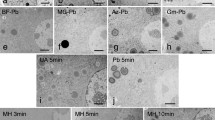Summary
We describe a new polychrome stain and simultaneous methods of histological, histochemical and immunocytochemical staining performed on sections from human tissues embedded in the new hydrophilic resin Bioacryl. The polychrome stain involves the sequential use of Harris' Haematoxylin, silver methenamine, Light Green and Eosin or Safranin dyes and provides a highly specific visualization of the overall cytological tissue architecture. When histochemical, immunocytochemical, and polychrome stains are performed together on the same section, crisp images are obtained, yielding simultaneous data of histochemical and immunological reactivities with clear tissue architecture.
Similar content being viewed by others
References
Bendayan, M., Nanci, A. & Kan, F. W. K. (1987) Effect of tissue processing on colloidal gold cytochemistry. J. Histochem. Cytochem. 35, 983–96.
Craig, S. & Miller, C. (1984) LR White resin and improved on-grid immunogold detection of vinilin, a pea seed storage protein. Cell. Biol. Int. Rep. 8, 879–86.
Danscher, G. & Norgaard, J. O. R. (1983) Light microscopic visualization of colloidal gold on resin-embedded tissue. J. Histochem. Cytochem. 31, 1394–98.
DeWaele, M., DeMey, J., Renmans, W., Lauber, C., Jochmans, K. & VanCamp, B. (1986) Potential of immunogold-silver staining for the study of leukocyte subpopulations as defined by monoclonal antibodies. J. Histochem. Cytochem. 34, 1257–63.
Gerrits, P. O., Horobin, R. W. & Wright, D. J. (1990) Staining sections of water-miscible resins. 1. Effects of the molecular size of the stain, and of resin cross-linking, on the staining of glycol methacrylate embedded tissues. J. Microsc. 160, 279–90.
Glauert, A. M. (1974) Fixation, dehydration and embedding of biological specimens. In Practical Methods in Electron Microscopy (edited by Glauert, A. M.) Vol 3. pp. 5–48. Amsterdam: North Holland/American Elsevier.
Hayat, M. A. (1975) Staining of semithin sections. In Positive Staining for Electron Microscopy (edited by Hayat, M. A.). pp. 256–75. New York: Van Nostrand Reinhold Co.
Hobot, J. A. K. & Newman, G. R. (1991) Strategies for improving the cytochemical and immunocytochemical sensitivity of ultrastructurally well-preserved, resin embedded biological tissue for light and electron microscopy. Scanning Microsc. (suppl) 5, S27–41.
Horobin, R. W. (1983) Staining plastic sections: a review of problems, explanations and possible solutions. J. Microsc. 131, 173–86.
Horobin, R. W., Gerrits, P. O. & Wright, D. J. (1992) Staining sections of water-miscible resins. 2. Effects of stainingreagent lipophilicity on the staining of glycol-methacrylate-embedded tissues. J. Microsc. 166, 199–205.
Laschi, R. & Govoni, E. (1978) Staining methods for semithin sections. In Electron Microscopy in Human Medicine (edited by JohannessenJ. V.), Vol 1. pp. 187–98. New York: McGraw-Hill.
LewisP. R. & KnightD. P. (1980) Staining methods for sectioned material. In Practical Methods in Electron Microscopy (edited by Glauert, M. A.) Vol 5, Pt 1. pp. 26–30. Amsterdam: North Holland Publishing Co.
LitwinJ. A. (1985) Light microscopic histochemistry on plastic sections. Prog. Histochem. Cytochem. 16, 1–84.
Manara, G. C., Preda, P., Pasquinelli, G., Ferrari, C., DePanfilis, G. & Scala, C. (1993) The use of the new hydrophilic resin Bioacryl in dermatological investigations. Eur. J. Dermatol. 3, 235–8.
Newman, G. R. & Hobot, J. A. (1987) Modern acrylics for post-embedding immunostaining techniques. J. Histochem. Cytochem. 35, 971–81.
Newman, G. R., Jasani, B. & Williams, E. D. (1983) A simple post-embedding system for the rapid demonstration of tissue antigens under the electron microscope. Histochem. J. 15, 543–55.
Roth, J., Bendayan, M., Carlemalm, E., Villiger, W. & Garavito, M. (1981) Enhancement of structural preservation and immunocytochemical staining in low temperature embedded pancreatic tissue. J. Histochem. Cytochem. 29, 663–71.
Scala, C., Cenacchi, G., Ferrari, C., Pasquinelli, G., Preda, P. & Manara, G. C. (1992) A new acrylic resin formulation: a useful tool for histological, ultrastructural, and immunocytochemical investigations. J. Histochem. Cytochem. 40, 1799–804.
Sjostrand, F. S. (1990) Common sense in electron microscopy. About cryofixation, freeze substitution, low temperature embedding, and low denaturation embedding. J. Struct. Biol. 103, 135–9.
Author information
Authors and Affiliations
Rights and permissions
About this article
Cite this article
Scala, C., Preda, P., Cenacchi, G. et al. A new polychrome stain and simultaneous methods of histological, histochemical and immunohistochemical stainings performed on semithin sections of Bioacryl-embedded human tissues. Histochem J 25, 670–677 (1993). https://doi.org/10.1007/BF00157881
Received:
Revised:
Issue Date:
DOI: https://doi.org/10.1007/BF00157881




